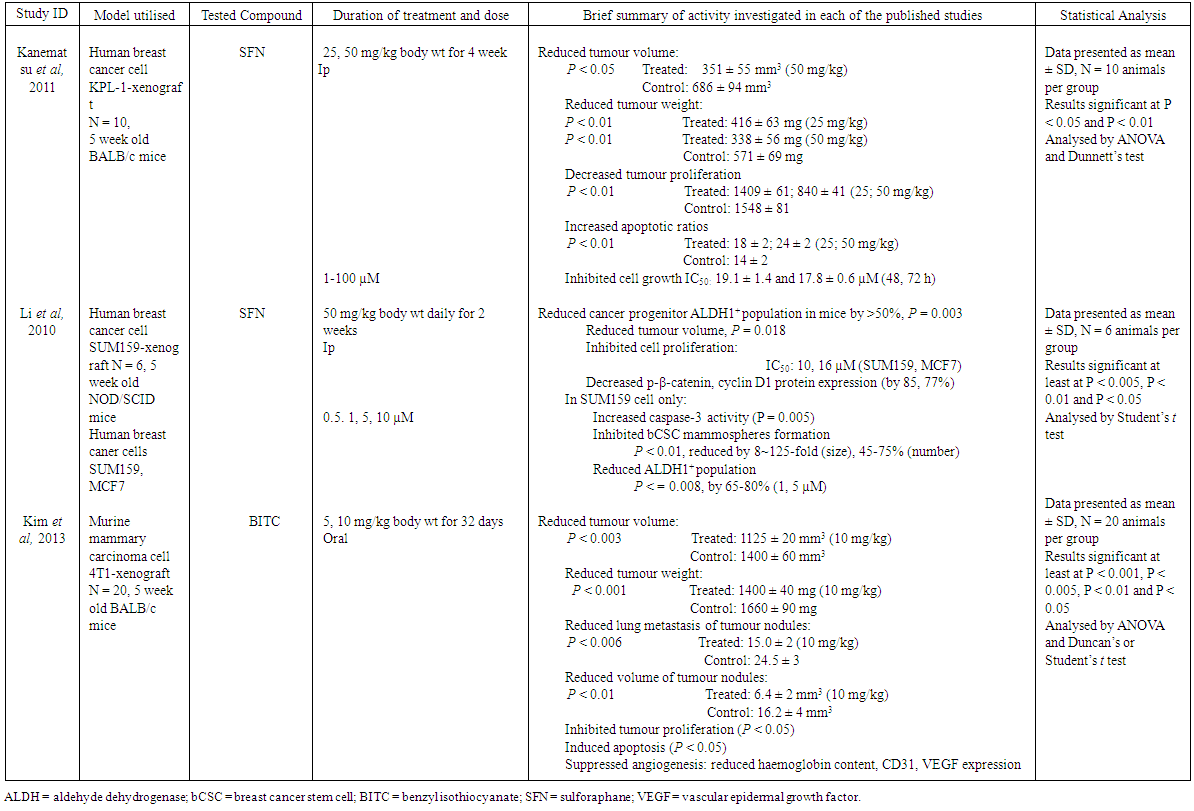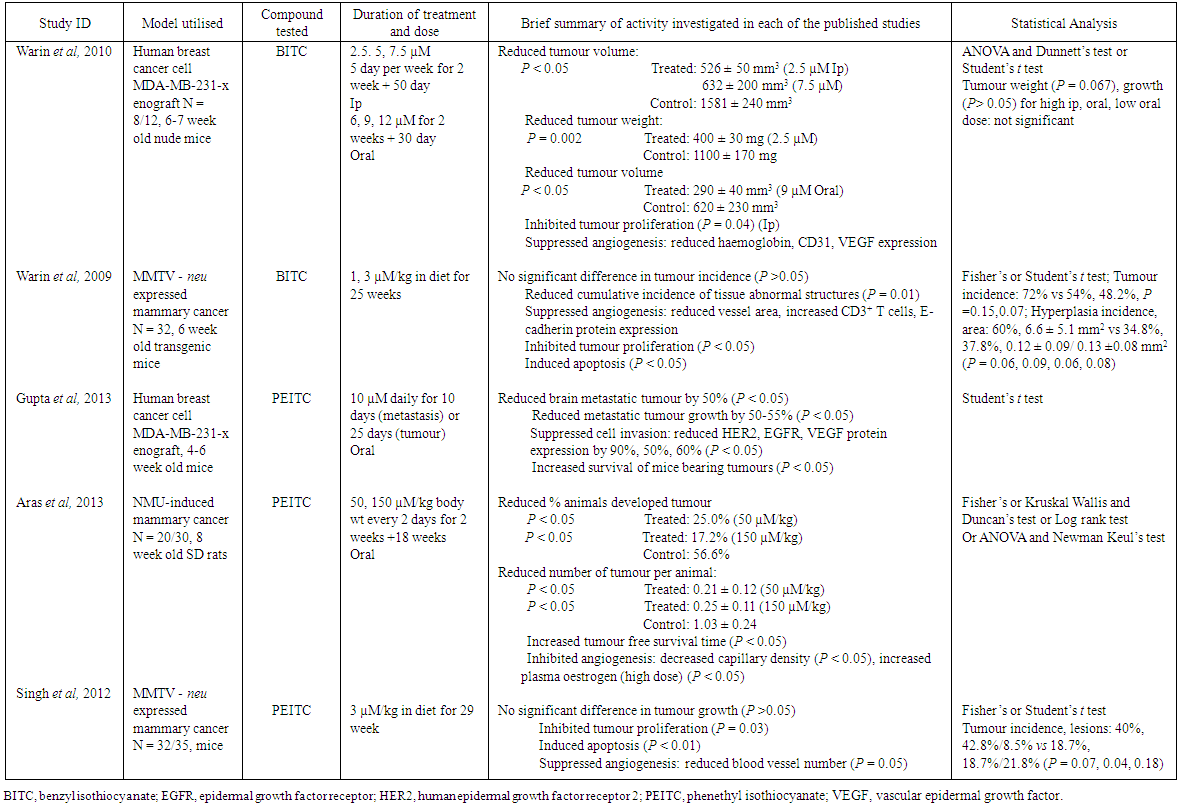-
Paper Information
- Paper Submission
-
Journal Information
- About This Journal
- Editorial Board
- Current Issue
- Archive
- Author Guidelines
- Contact Us
International Journal of Biological Engineering
p-ISSN: 2163-1875 e-ISSN: 2163-1883
2016; 6(1): 7-11
doi:10.5923/j.ijbe.20160601.02

Are Isothiocyanates from Cruciferous Vegetables Potential Therapeutic Agents for Breast Cancer
Suong NT Ngo
The University of Adelaide, Roseworthy Campus, Roseworthy, South Australia, Australia
Correspondence to: Suong NT Ngo, The University of Adelaide, Roseworthy Campus, Roseworthy, South Australia, Australia.
| Email: |  |
Copyright © 2016 Scientific & Academic Publishing. All Rights Reserved.
This work is licensed under the Creative Commons Attribution International License (CC BY).
http://creativecommons.org/licenses/by/4.0/

Background: The important role of food bioactive compounds in the reduction of cancer risk has been highlighted by extensive research over the last two decades. Consumption of cruciferous vegetables in particular, rather than vegetables as a group has drawn a great deal of attention in cancer research due to their potential protective properties. The health benefits of cruciferous vegetables have been well reported being attributed to their rich sources of isothiocyanates and indole constituents. This paper focused on the activity of isothiocyanate constituents in breast cancer. Methods: Studies and data sources: Medline and Pubmed were searched for studies using key terms isothiocyanate and breast cancer as text words and as exploded subject headings where possible. Other key terms such as sulforaphane, benzyl isothiocyanate, phenethyl isothiocyanate, allyl isothiocyanate and breast cancer were also searched to check for appropriate studies. The search included all studies published from 1995 up to December 2015. Relevant studies cited in the primary-search published before 1995 were also included in the review. Inclusion criteria: The following inclusion criteria were applied in the screening of articles: 1) study published in English; 2) study compared ITC treated group with a control; 3) study examined breast cancer tumour or breast cancer cells; 4) study examined anticancer effect; 5) statistical analysis was provided. The search resulted in 3 human clinical trials and 49 preclinical in vivo and in vitro studies. Results&Discussion:There were substantial preclinical data over the last two decades, which reported the activity of various isothiocyanate constituents in breast cancer cell lines and animal models of breast cancer tumour, with a limited number of studies from human clinical trials. Recent studies have also found that isothiocyanates exhibited significant activity against breast cancer stem cells as well as breast cancer bull cells, which is generally thought as a new and innovative approach for targeting breast cancer treatment. The most extensively investigated cruciferous vegetables’ active constituents included sulforaphane, benzyl isothiocyanate and phenethyl isothiocyanate, and overall, at pharmacological concentration range of 1-10 µM for sulforaphane and 2.5-5 µM for benzyl isothiocyanate, and phenethyl isothiocyanate with a wide undefined, varied range of concentrations, these food bioactive compounds demonstrated a highly desirable activity at the cellular and molecular levels, therefore they are likely to show great promise for use in humans as anti-cancer therapeutic agents.
Keywords: Anti-cancer activity, Cruciferous vegetables, Isothiocyanates, Breast cancer
Cite this paper: Suong NT Ngo, Are Isothiocyanates from Cruciferous Vegetables Potential Therapeutic Agents for Breast Cancer, International Journal of Biological Engineering, Vol. 6 No. 1, 2016, pp. 7-11. doi: 10.5923/j.ijbe.20160601.02.
1. Introduction
- Over the last two decades, there has been growing research interest that focused on the health benefits of cruciferous vegetables in the prevention of cancer of various sites, including breast cancer. The cancer protective effects of these vegetables have been well believed to be due to the active constituents glucosinolates as well as the indole compounds, this article will focus specifically on the main isothiocyanate constituents, including sulforaphane, benzyl isothiocyanate, phenethyl isothiocyanate and will also highlight relevant published human studies which examined the association between cruciferous vegetables intake and breast cancer risk in patients. The chemical structures of the main active isothiocyanate constituents from cruciferous vegetables are provided in Figure 1.
 | Figure 1. Chemical structures of isothiocyanate constituents from cruciferous vegetables |
2. Methods
- Studies and data sourcesMedline and Pubmed were searched for studies using key terms isothiocyanate and breast cancer as text words and as exploded subject headings where possible. Other key terms such as cruciferous vegetables, sulforaphane, benzyl isothiocyanate, phenethyl isothiocyanate, allyl isothiocyanate, and breast cancer were also searched to check for appropriate studies. The search included all studies published from 1995 up to December 2015. Relevant studies cited in the primary-search published before 1995 and clinical studies examined cruciferous vegetables intake and breast cancer risk in patients were also screened and discussed in the review. Inclusion criteriaThe following inclusion criteria were applied in the screening of articles from published animal models of breast tumour, cancer: 1) study published in English; 2) study compared ITC treated group with a control; 3) study examined breast cancer tumour or breast cancer cells; 4) study examined anticancer effect; 5) statistical analysis was provided.
3. Results
- The search resulted in a total of 4 clinical studies, 9 animal models and 40 in vitro breast cancer cell culture studies. No human randomised control trial that examined the outcomes of in take of cruciferous vegetables or isothiocyanates in breast cancer patients was identified from the literature search. Two of the four clinical studies identified were human case-control trials and these trials overall reported a reduced cancer risk associated with cruciferous vegetables consumption. Specifically, in a study involved 2832 patients, consumption of cruciferous vegetables was found to be inversely associated with breast cancer risk (RR = 0.58, 95% CI (0.42-0.79), P = 0.03) (Terry et al., 2001). In another study of 740 patients, reduced breast cancer risk was reported to be associated with broccoli consumption (OR = 0.60, 95% CI (0.40-1.01), P = 0.058 (Ambrosone et al., 2004). It was worth to note that the finding in the later study did not reach statistical significance at P < 0.05. The other two clinical trials were both pilot studies, which examined pharmacokinetics of intake of broccoli and isothiocyanates constituents in healthy women or individuals (Atwell et al., 2015; Cornblatt et al., 2007). Overall, although the findings from published clinical case-control trials were not all significant outcomes; they do provide some good evidence to support the potential protective role of cruciferous vegetables in breast cancer patient.The activity reported from published animal models of breast cancer appeared to be variable and the reported results seemed to be dependent partly on the experimental model being employed. Three studies, which utilised a transgenic mice model, reported no significant difference in mammary tumour growth between benzyl or phenethyl isothiocyanate treated versus the control groups (Kim et al., 2013; Singh et al., 2012; Warin et al., 2009). However, in another study which employed a different human breast cancer xenograft model of nude mice injected with MDA-MB-231-cells, it was found that benzyl isothiocyanate had activity in reducing the tumour volume (Warin et al., 2010). Another study, which used a rat model of NMU-induced mammary cancer, reported that at concentration of 50µM/kg animal’s body weight for 2 weeks of treatment, the phenethyl isothiocyanate decreased the percentage of rats with mammary tumour phenethyl isothiocyanate was later investigated by and colleagues (Aras et al., 2013). In addition, phenethyl isothiocyanate has also been found to have inhibitory activity in breast tumour metastasis, migration of mammary tumour to other site, the brain, however, this study did not specifically examine the compound’s activity on mammary tumour incidence (Gupta et al., 2013). A brief summary of activity investigated in each of the published animal models of breast cancer tumours, which examined sulforaphane, benzyl isothiocyanate, or phenethyl isothiocyanate are provided in Table 1.
 | Table 1. Anti-breast cancer activity of isothiocyanates from cruciferous vegetables from animal models published from 1995 to December 2015 |
 | Table 2. Activity of isothiocyanates from cruciferous vegetables in breast cancer from animal models published from 1995 to December 2015(cont) |
 Abstract
Abstract Reference
Reference Full-Text PDF
Full-Text PDF Full-text HTML
Full-text HTML